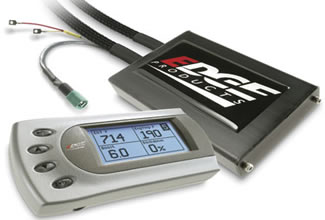August 20, 2012
By Bruce Smith
Plug-in electronic performance products give diesel trucks a lot more go.
By Bruce Smith

Aftermarket hot-rodding kits like this sell for a couple of hundred bucks. |
Diesel hot-rodding across the country is booming, bringing with it a huge number of new manufacturers and products that can turn diesel pickups and SUVs into surprising performers. This bodes well for those Florida sportsmen who have moved up in boat size, but now find their diesel-powered tow rigs planted in the slow lane.
These cool “white-glove” products are called modules and programmers. Don't get intimidated; all can be installed or used by anyone capable of using a cell phone, Blackberry or Palm Pilot.
Better still, most of these electronic hot-rodding products can be installed or used by anyone in minutes without lifting a wrench, and the result can instantly add more than 100 horsepower to your tow rig.
I've used several types and have seen the dyno tests first-hand.
They work.
One is the new Edge Juice ($450) from Edge Performance Products (
www.edgeproducts.com; 888-360-3343) in Arizona. The Juice is a little plug-and-go module that intercepts signals from Ford and Cummins diesel engine sensors and changes that information before it reaches the factory engine control unit (ECU).
This fools the ECU into thinking the engine is running under more demanding or different operating conditions, thus making it produce a lot more power with less throttle. The Juice has three power-level modes, plus stock. You can also get the optional Attitude monitor ($299, or buy the two as a kit for $615) that gives you five power levels and digital read-out gauges that show exhaust gas temperature, turbo boost, engine rpm, and more information in a dash-mounted display. That is the way to fly.
Edge claims the Juice/Attitude combo bumps the power output 25hp and 50 lb/ft in Level 1 (Mileage) incrementally to 75hp and 200 lb/ft in Level 5 (Extreme). That may sound a bit optimistic to some, but I have run this package on a 2001 F-250 7.3-liter diesel and saw the dyno numbers that showed Edge's claims are not the least inflated.
On the road the difference in towing performance is just as impressive. I used a computerized Stalker ATS radar system to measure performance. It showed a 0-60 mph time of 20.9 seconds in stock form with a 5,000-pound boat in tow, and a 40-60 mph time of 11.1 seconds. Not a rocket by any means.
Setting the Juice/Attitude Module to Level 3 (Tow), those times dropped to 12.9 and 6.4 seconds respectively. Clipping eight seconds off 0-60 mph and nearly five seconds off the 40-60 mph times is huge when it comes to tow vehicle performance.
There are several companies out there that offer similar performance modules, including Gale Banks Engi-neering (www.Bankspower.com; 877 227-1691); Bully Dog (
www.bullydog.com; 208-397-3200); TSP Performance (www.tsperformance.com; 270-746-9999); Hypertech (
www.hypertech.com; 901-382-8888); Superchips (
www.superchips.com; 888-227-2447); and Quadzilla (
www.quadzillapower.com; 888-842-6572.)
The other part of electronic hot-rodding is re-programming, or flashing, the factory engine computer. Again, don't be intimidated by the reprogramming phrase; most of the steps require you to do nothing more than turn the vehicle's ignition key on and off as instructed by the programmer or “tuner.”
Such simple instructions lead you through the programmer's steps that download the factory program, save it, and then upload (flashes) a new performance program in its place. To go back to stock, you follow the same easy steps. The Edge Evolution I took less than 5 minutes to reprogram the Ford ECU and added more than 100 hp.
Re-programming the ECU doesn't give you the wide range (you only have one choice) of instant power options that modules do, but it can result in even more power. These products are a viable performance option for those who don't like to fiddle with power settings—and the same companies that offer modules usually offer programmers.
Diesels don't usually fall under the same emissions standards as gas engines, so meeting state or federal vehicle rules and regulations shouldn't be a big concern. But warranties might. Although the lower power settings of these power plug-ins are probably well within engine and drivetrain operating limits, the highest settings are on the edge for towing. As with any performance part that changes how the ECU operates, you risk warranty coverage if the dealer sees what's been done and can trace the warranty issue directly to those modifications. All of these modules and programmers can be unplugged or can easily reprogram the factory computer so you'd likely be the only one who knew they were even there. But it's up to your conscience to decide what's okay and what's not.
In any case, problems caused by the units are extremely rare. When used in accordance to manufacturers' recommendations, these white-glove electronic performance parts function seamlessly and in harmony with your vehicle's diesel engine.
Whether you choose module or re-programmer, these new plug-and-go electronic hot-rodding parts result in
a tow vehicle that does the job of pulling a big boat and trailer with a lot more ease. For those towing big multi-engine kingfish rigs and the like, the extra power can mean a lot—especially when you're faced with fitting that big rig into the flow of 70-mph traffic as you pull on to an interstate highway.
FS
Read about this topic on the forum.

